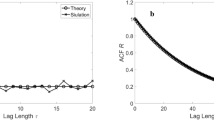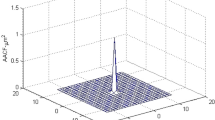Abstract
Three-dimensional asperity model of rough surfaces is proposed using valley–peak ratio (VPR) of the maximum peak. Asperities of rough surfaces are reconstructed according to paraboloid asperity function, which is derived using least square method and asperity projection plane determined via VPR. The minimum profile deviation between reconstructed asperities and rough surface is calculated using simulated annealing method to optimize VPR. Effects of simulated mutation surfaces, measured surfaces, and different sampling intervals (SIs) on profile deviation are investigated. Compared with nine–point method, the proposed model demonstrates a smaller deviation of mutational rough surface, the absence of interference among asperities, and more stable surface parameters and contact mechanics performance at different SIs.


















Similar content being viewed by others
References
Muthukumar M, Bobji MS (2018) Effect of micropillar surface texturing on friction under elastic dry reciprocating contact. Meccanica 53:2221–2235
Czifra Á, Váradi K, Horváth S (2008) Three dimensional asperity analysis of worn surfaces. Meccanica 43:601
Hannes D, Alfredsson B (2012) Surface initiated rolling contact fatigue based on the asperity point load mechanism—a parameter study. Wear 294–295:457–468
Chong WWF, De la Cruz M (2014) Elastoplastic contact of rough surfaces: a line contact model for boundary regime of lubrication. Meccanica 49:1177–1191
Hu B, Zhou C, Wang H, Chen S (2021) Nonlinear tribo-dynamic model and experimental verification of a spur gear drive under loss-of-lubrication condition. Mech Syst Signal Process 153:107509
Gadelmawla ES, Koura M, Maksoud T, Elewa I, Soliman H (2002) Roughness parameters. J Mater Process Technol 123:133–145
Wei Z, Jin-yuan T, Yan-fei H, Cai-chao Z (2017) Modeling of rough surfaces with given roughness parameters. J Cent South Univ 24:127–136
Greenwood JA, Williamson JBP (1966) Contact of nominally flat surfaces. Proc R Soc Lond A 295:300–319
Pullen J, Williamson JBP (1972) On the plastic contact of rough surfaces. Proc R Soc Lond A 327:159–173
Chang W-R, Etsion I, Bogy D (1987) An elastic-plastic model for the contact of rough surfaces. J Tribol Transac 109:257–263
Zhao Y, Maietta DM, Chang L (2000) An asperity microcontact model incorporating the transition from elastic deformation to fully plastic flow. J Tribol 122:86–93
Persson BNJ (2001) Theory of rubber friction and contact mechanics. J Chem Phys 115:3840–3861
Persson BNJ (2006) Contact mechanics for randomly rough surfaces. Surf Sci Rep 61:201–227
Pugliese G, Tavares SMO, Ciulli E, Ferreira LA (2008) Rough contacts between actual engineering surfaces. Wear 264:1116–1128
Wen Y, Tang J, Zhou W, Zhu C (2018) A new elliptical microcontact model considering elastoplastic deformation. Proc Inst Mech Eng, Part J: J Eng Tribol 232:1352–1364
Peng W, Bhushan B (2001) Three-dimensional contact analysis of layered elasticplastic solids with rough surfaces. Wear 249(741):760
Kogut L, Etsion I (2002) Elastic-plastic contact analysis of a sphere and a rigid flat. J Appl Mech-transac 69:657–662
Buczkowski R, Kleiber M (2009) Statistical models of rough surfaces for finite Element 3D-contact analysis. Archiv Comput Methods Eng 16:399–424
Yastrebov VA, Anciaux G, Molinari J-F (2015) From infinitesimal to full contact between rough surfaces: evolution of the contact area. Int J Solids Struct 52:83–102
Ciavarella M (2016) Rough contacts near full contact with a very simple asperity model. Tribol Int 93:464–469
Yastrebov VA, Anciaux G, Molinari J-F (2017) On the accurate computation of the true contact-area in mechanical contact of random rough surfaces. Tribol Int 114:161–171
Bhagwat P, Sista B, Vemaganti K (2017) A computational study of the effects of strain hardening in micro-asperity friction models. Tribol Lett 65:154
Pondicherry K, Rajaraman D, Galle T, Hertelé S, Fauconnier D, De Baets P (2020) Optimization and validation of a load-controlled numerical model for single asperity scratch. Tribol Lett 68:45
Zheng X, Zhu H, Tieu AK, Kosasih B (2014) Roughness and lubricant effect on 3d atomic asperity contact. Tribol Lett 53:215–223
Kucharski S, Starzynski G (2014) Study of contact of rough surfaces: Modeling and experiment. Wear 311:167–179
Jedynak R, Sułek M (2014) Numerical and experimental investigation of plastic interaction between rough surfaces. Arabian J Sci Eng 39:4165–4177
Brodnik Žugelj B, Kalin M (2017) In-situ observations of a multi-asperity real contact area on a submicron scale. Strojniški vestnik—J Mech Eng 63:351–362
Hu Y, Tonder K (1992) Simulation of 3-D random rough surface by 2-D digital filter and fourier analysis. Int J Mach Tools Manuf 32:83–90
Zhou W, Tang J, Huang Z (2015) A new method for rough surface profile simulation based on peak-valley mapping. Tribol Trans 58:971–979
Greenwood JA, Wu JJ (2001) Surface roughness and contact: an apology. Meccanica 36:617–630
Pogačnik A, Kalin M (2013) How to determine the number of asperity peaks, their radii and their heights for engineering surfaces: a critical appraisal. Wear 300:143–154
Aramaki H, Cheng HS, Chung Y-W (1993) The contact between rough surfaces with longitudinal texture—Part I: average contact pressure and real contact area. J Tribol 115:419–424
Ciulli E, Ferreira LA, Pugliese G, Tavares SMO (2008) Rough contacts between actual engineering surfaces. Wear 264:1105–1115
Wen Y, Tang J, Wei Z, Zhu C (2018) An improved simplified model of rough surface profile. Tribol Int 125:75–84
Kalin M, Pogačnik A (2013) Criteria and properties of the asperity peaks on 3D engineering surfaces. Wear 308:95–104
Barre´ F, Lopez J (2020) Watershed lines and catchment basins: a new 3D-motif method. Int J Mach Tools Manuf 40:1171–84
Wen Y, Wei JT, Zhou W, Li L (2020) A reconstruction and contact analysis method of three-dimensional rough surface based on ellipsoidal asperity. J Tribol 142:4
Thomas TR, Rosén B-G (2000) Determination of the optimum sampling interval for rough contact mechanics. Tribol Int 33:601–610
Pawlus P, Zelasko W (2012) The importance of sampling interval for rough contact mechanics. Wear 276–277:121–129
Johnson KL. Contact Mechanics: journal of tribology; 1985.
Ciavarella M, Papangelo A (2017) Discussion of measuring and understanding contact area at the nanoscale: a review. Appl Mech Rev 69(6):060802
Papangelo A, Hoffmann N, Ciavarella M (2017) Load-separation curves for the contact of self-affine rough surfaces. Sci Rep 7:6900
Castagnetti D, Dragoni E (2016) Experimental investigation and model validation of the shear strength of hybrid interfaces up to complete failure. J Adhes 92:679–697
Castagnetti D, Dragoni E (2014) Adhesively-bonded friction interfaces: Macroscopic shear strength prediction by microscale finite element simulations. Int J Adhes Adhes 53:57–64
Acknowledgements
The authors gratefully acknowledge the support by the National Natural Science Foundation of China (Grant No. 52075153 and 52005051) and Natural Science Foundation of Hunan Province (Grant No. 2019JJ40020).
Author information
Authors and Affiliations
Corresponding authors
Additional information
Publisher's Note
Springer Nature remains neutral with regard to jurisdictional claims in published maps and institutional affiliations.
Rights and permissions
About this article
Cite this article
Zhou, C., Wang, H., Wang, H. et al. Three-dimensional asperity model of rough surfaces based on valley–peak ratio of the maximum peak. Meccanica 56, 711–730 (2021). https://doi.org/10.1007/s11012-021-01309-3
Received:
Accepted:
Published:
Issue Date:
DOI: https://doi.org/10.1007/s11012-021-01309-3




